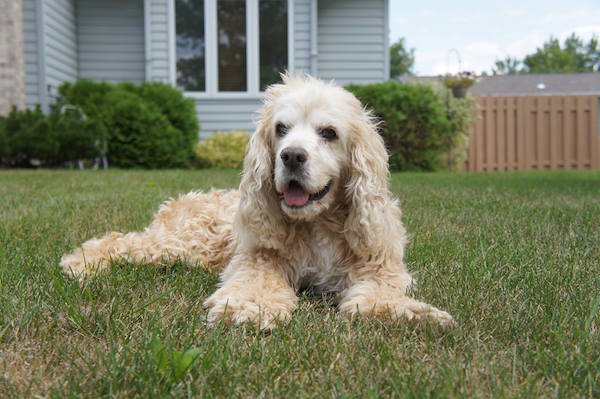
Deaf Dog Awareness week isn’t until September, but this is advanced notice that we’ll be covering these dogs when the time comes, so be ready to share your pictures. That said, a caveat. We’re not experts on canine deafness, and we’ll always defer to the people who know more about this than we do. For the moment, we’ll share what we do know.
Some dogs lose their hearing because of an ear infection. Some suffer an injury, some react badly to certain drugs, and some just succumb to old age. Exposure to loud sounds can also cause temporary or permanent deafness, We’ve read, however, that the most common cause of congenital deafness (meaning from birth) is pigment related, and that some 30 breeds are said to have a known susceptibility for deafness for that reason.
Merle is a dominant gene. A dog needs only one copy to have a merled coat. Dogs with two copies of the merle gene are referred to as having a “Double Merle.” Double Merle pups are born when both of the parents are merle (it doesn’t matter what color or breed). Statistically, 25% of the pups from two merle parents will be Double Merles. When the dog has two copies, instead of producing only partial lightening, the effect is doubled, causing some to most of the coat to turn white. These dogs are also sometimes referred to being “lethal whites,” a term that came to be used with double merle’s because these puppies were sometimes euthanized at birth by breeders who knew they could be deaf and/or blind (read: it pays to work with an ethical breeder who knows their breed and what they’re doing).
“Some dogs are naturally white such as Samoyeds, Bichons, and West Highland Terriers. These dogs were created to be white and as a result their skin is pigmented. The fur will appear white, but the skin underneath is pigmented along with the nose and eye rims. The merle gene whitens and take the skin pigment with it. When that gene is doubled, it pulls even more pigment from the skin. If the dog lacks pigment in the inner ear, the tiny little hairs/nerve endings will fall off and die very early in the dogs life. This occurs within the first 3 weeks of the dogs life. The inside of the dogs ear along with the tiny hair is not something that can be seen. It’s often said that dogs with white ears will be deaf, but this is not always the case.”
Few among us who’ve been blessed with a dog living into old age haven’t noticed a diminishment in the dog’s hearing. Slight hearing loss can be hard to detect, and sometimes the deficit has to become profound before we really notice it. Usually, geriatric hearing loss is irreversible, but that doesn’t mean the dog can’t still enjoy his life and relationships. Often, younger dogs in the family will
look out for the dog, but hand signals become increasingly helpful and many experts suggest teaching hand signals to all dogs while they’re young in the event that hearing loss is part of their golden years. The use of lights to signal dogs (e.g.; flashing the yard light when you want the dog to come in from outside) can be also be useful. Remember, too, that dogs with hearing loss can still sense vibration, so clapping hands or stomping on the floor can alert the dog you are trying to communicate with him.
A couple of other tips: Get a disaster whistle and condition it as a recall cue by pairing its sound with high-value treats. The Storm Whistle, reported to be twice as loud as any other mouth-blown whistle in the world, is available in stores, catalogues, and from stormwhistles.com (314-436-3332). ) Also, give your dog the benefit of the doubt and make reasonable accommodations. Remember that your dog isn’t ignoring you, he or she just can’t hear you! Condition your dog to an unexpected touch from behind so you can let her know you’re there and need her to move, or go around him.
Image of “Toby,” a 16 year old Cocker Spaniel a day before he passed on. RIP, dear Toby. Photo by Marah Smith

